 |
GOTHIC ARCHITECTURE IN GREAT BRITAIN:GENERAL CHARACTER |
| << GOTHIC ARCHITECTURE IN FRANCE:STRUCTURAL DEVELOPMENT |
| GOTHIC ARCHITECTURE IN GERMANY, THE NETHERLANDS, AND SPAIN >> |
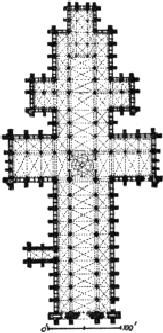
CHAPTER
XVII.
GOTHIC
ARCHITECTURE IN GREAT
BRITAIN.
BOOKS RECOMMENDED: As before, Corroyer,
Parker, Reber. Also, Bell's
Series of
Handbooks
of English Cathedrals.
Billings, The
Baronial and Ecclesiastical Antiquities
of
Scotland.
Bond, Gothic
Architecture in England.
Brandon, Analysis
of Gothic
Architecture.
Britton, Cathedral
Antiquities of Great
Britain.
Ditchfield, The
Cathedrals
of
England. Murray,
Handbooks
of the English Cathedrals.
Parker, Introduction
to
Gothic
Architecture;
Glossary
of Architectural Terms;
Companion
to Glossary,
etc.
Rickman,
An
Attempt to Discriminate the
Styles of English
Architecture.
Sharpe,
Architectural
Parallels;
The
Seven Periods of English
Architecture. Van
Rensselaer,
English
Cathedrals.
Winkles and Moule, Cathedral
Churches of England and
Wales.
Willis,
Architectural
History of Canterbury
Cathedral; ditto
of
Winchester Cathedral;
Treatise
on Vaults.
GENERAL
CHARACTER. Gothic
architecture was developed in
England under a
strongly
established royal power, with an
episcopate in no sense hostile to the
abbots
or
in arms against the barons. Many of the
cathedrals had monastic chapters,
and
not
infrequently abbots were
invested with the episcopal rank.
FIG.
128.--PLAN OF SALISBURY
CATHEDRAL.
English
Gothic architecture was thus by no
means predominantly an architecture
of
cathedrals.
If architectural activity in England
was on this account less
intense and
widespread
in the twelfth and thirteenth centuries than in
France, it was not, on the
other
hand, so soon exhausted. Fewer new
cathedrals were built, but the
progressive
rebuilding
of those already existing
seems not to have ceased until the
middle or end
of
the fifteenth century. Architecture in
England developed more slowly, but
more
uniformly
than in France. It contented itself with
simpler problems; and if it failed
to
rival
Amiens in boldness of construction and in
lofty majesty, it at least
never
perpetrated
a folly like Beauvais. In richness of
internal decoration, especially in
the
mouldings
and ribbed vaulting, and in the
picturesque grouping of simple
masses
externally,
the British builders went far toward
atoning for their structural
timidity.
EARLY
GOTHIC BUILDINGS. The
pointed arch and ribbed vault
were importations
from
France. Early examples
appear in the Cistercian abbeys of
Furness and Kirkstall,
and
in the Temple Church at London (1185).
But it was in the Choir
of Canterbury,
as
rebuilt by William of Sens,
after the destruction by fire in 1170 of
Anselm's
Norman
choir, that these French
Gothic features were first
applied in a
thoroughgoing
manner. In plan this choir resembled that
of the cathedral of Sens;
and
its coupled round piers, with
capitals carved with foliage,
its pointed arches,
its
six-part
vaulting, and its chevet,
were distinctly French. The
Gothic details thus
introduced
slowly supplanted the round arch and
other Norman features. For
fifty
years
the styles were more or less
mingled in many buildings, though
Lincoln
Cathedral, as
rebuilt in 11851200, retained
nothing of the earlier
round-arched
style.
But the first church to be designed and built from the
foundations in the new
style
was the cathedral of Salisbury
(12201258;
Fig. 128). Contemporary with
Amiens,
it is a homogeneous and typical example
of the Early English style.
The
predilection
for great length observable in the
Anglo-Norman churches (as at
Norwich
and
Durham) still prevailed, as it continued
to do throughout the Gothic
period;
Salisbury
is 480 feet long. The double
transepts, the long choir, the
square east end,
the
relatively low vault (84 feet to the
ridge), the narrow grouped windows, all
are
thoroughly
English. Only the simple four-part
vaulting recalls French
models.
Westminster
Abbey (12451269),
on the other hand, betrays in a marked
manner
the
French influence in its
internal loftiness (100 feet),
its polygonal chevet
and
MIXTURE
OF STYLES. Very few
English cathedrals are as
homogeneous as the two
just
mentioned, nearly all having
undergone repeated remodellings in
successive
periods.
Durham, Norwich, and Oxford are wholly Norman but for
their Gothic
vaults.
Ely, Rochester, Gloucester, and Hereford
have Norman naves and
Gothic
choirs.
Peterborough has an early
Gothic façade and late
Gothic retro-choir added
to
an
otherwise completely Norman structure.
Winchester is a Norman church
remodelled
with early Perpendicular details. The
purely Gothic churches and
cathedrals,
except parish churches--in which
England is very rich--are not nearly
as
numerous
in England as in France.
PERIODS.
The
development of English Gothic
architecture followed the same
general
sequence
as the French, and like it the successive
stages were most
conspicuously
characterized
by the forms of the tracery.
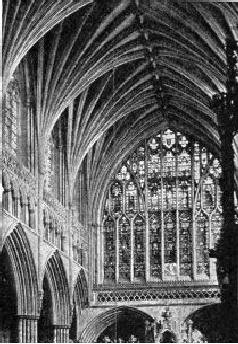
The
EARLY ENGLISH or
LANCET
period
extended roundly from 1175 or 1180 to 1280,
and
was marked by simplicity, dignity, and
purity of design.
The
DECORATED or GEOMETRIC period
covered another century, 1280 to 1380,
and
was
characterized by its decorative
richness and greater lightness of
construction.
The
PERPENDICULAR period extended
from 1380, or thereabout, well into the
sixteenth
century. Its salient features were the
use of fan-vaulting,
four-centred
arches,
and tracery of predominantly vertical and
horizontal lines. The tardy
introduction
of Renaissance forms finally put an end
to the Gothic style in
England,
after
a long period of mixed and
transitional architecture.
FIG.
129.--RIBBED VAULTING, CHOIR OF EXETER
CATHEDRAL.
VAULTING.
The
richness and variety of English
vaulting contrast strikingly with
the
persistent
uniformity of the French. A few of the early
Gothic vaults, as in the
aisles
of
Peterborough, and later the naves of
Durham, Salisbury, and Gloucester,
were
simple
four-part, ribbed vaults
substantially like the French. But the
English disliked
and
avoided the twisted and dome-like
surfaces of the French vaults,
preferring
horizontal
ridges, and, in the filling-masonry,
straight courses meeting at the
ridge in
zigzag
lines, as in southwest France.
This may be seen in Westminster
Abbey. The
idea
of ribbed construction was then
seized upon and given a new application.
By
springing
a large number of ribs from each point of
support, the vaulting-surfaces
were
divided into long, narrow, triangles, the
filling of which was comparatively
easy
(Fig.
129). The ridge was itself
furnished with a straight rib, decorated
with carved
rosettes
or bosses
at
each intersection with a vaulting-rib.
The naves and choirs of
Lincoln,
Lichfield, Exeter, and the nave of
Westminster illustrate this method.
The
logical
corollary of this practice was the
introduction of minor ribs called
liernes,
connecting
the main ribs and forming complex
reticulated and star-shaped
patterns.
Vaults
of this description are among the
most beautiful in England. One of the
richest
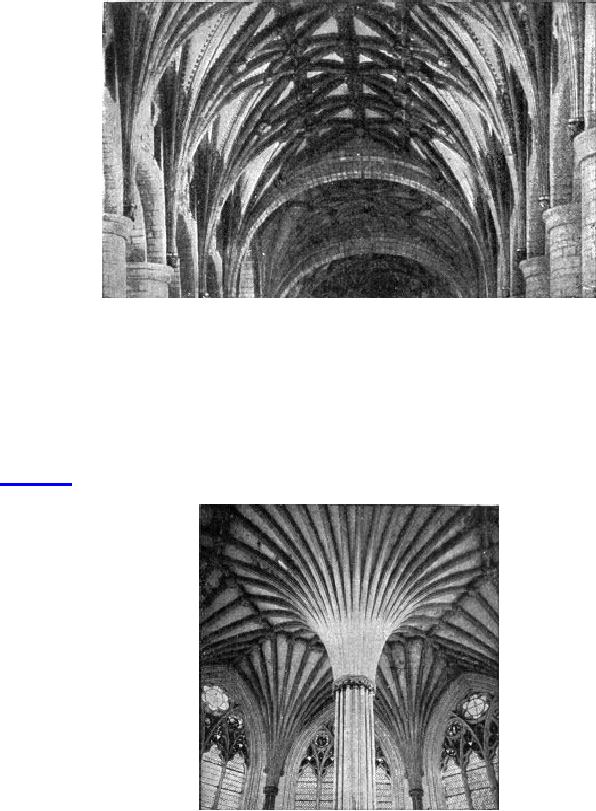
is
in the choir of Gloucester (13371377).
Less correct constructively is that
over
the
choir of Wells, while the choir of Ely,
the nave of Tewkesbury Abbey
(Fig. 130),
and
all the vaulting of Winchester as rebuilt
by William of Wykeham (1390),
illustrate
the same system. Such vaults
are called lierne
or
star
vaults.
FIG.
130.--NET OR LIERNE VAULTING,
TEWKESBURY ABBEY.
FAN-VAULTING.
The next
step in the process may be observed in
the vaults of the
choir
of Oxford Cathedral (Christ Church), of
the retro-choir of Peterborough, of
the
cloisters
of Gloucester, and many other examples.
The diverging ribs being
made of
uniform
curvature, the severeys
(the
inverted pyramidal vaulting-masses
springing
from
each support) became a
species of concave conoids,
meeting at the ridge in
such
a
way as to leave a series of flat
lozenge-shaped spaces at the summit of the
vault
FIG.
131.--VAULT OF CHAPTER-HOUSE,
WELLS.
The
ribs were multiplied
indefinitely, and losing thus in
individual and structural
importance
became a mere decorative
pattern of tracery on the severeys. To
conceal
the
awkward flat lozenges at the ridge,
elaborate panelling was
resorted to; or, in
some
cases, long stone pendents
were inserted at those
points--a device highly
decorative
but wholly unconstructive. At Cambridge, in
King's
College Chapel,
at
Windsor,
in St.
George's Chapel, and in the
Chapel
of Henry VII. at
Westminster,
this
sort of vaulting received
its most elaborate
development. The fan-vault, as it
is
called,
illustrates the logical evolution of a
decorative element from a
structural
starting--point,
leading to results far removed from the
original conception. Rich
and
sumptuous
as are these ceilings, they
are with all their ornament
less satisfactory
than
the ribbed vaults of the preceding
period.
CHAPTER-HOUSES.
One of the
most beautiful forms of
ribbed vaulting was
developed
in the polygonal halls erected for the
deliberations of the cathedral
chapters
of Lincoln (1225), Westminster (1250),
Salisbury (1250), and Wells
(1292),
in which the vault-ribs radiated from a
central column to the sides and
angles
of the polygon (Fig. 131). If these
vaults were less majestic
than domes of the
same
diameter, they were far more
decorative and picturesque, while the
chapter-
houses
themselves were the most
original and striking products of
English Gothic art.
Every
feature was designed with
strict regard for the structural
system determined by
the
admirable vaulting, and the Sainte
Chapelle was not more
logical in its
exemplification
of Gothic principles. To the four
above-mentioned examples
should
be
added that of York (12801330), which differs from
them in having no central
column:
by some critics it is esteemed the
finest of them all. Its ceiling is a
Gothic
dome,
57 feet in diameter, but unfortunately
executed in wood. Its
geometrical
window-tracery
and richly canopied stalls are
admirable.
OCTAGON
AT ELY. The
magnificent Octagon
of Ely
Cathedral, at the intersection of
the
nave and transepts, belongs in the
same category with these
polygonal chapter-
house
vaults. It was built by Alan of
Walsingham in 1337, after the fall of
the
central
tower and the destruction of the adjacent
bays of the choir. It occupies
the
full
width of the three aisles, and covers the
ample space thus enclosed with a
simple
but
beautiful groined and ribbed vault of
wood reaching to a central
octagonal
lantern,
which rises much higher and shows
externally as well as internally.
Unfortunately,
this vault is of wood, and would require
important modifications of
detail
if carried out in stone. But it is so
noble in general design and
total effect, that
one
wonders the type was not
universally adopted for the crossing in
all cathedrals,
until
one observes that no cathedral of
importance was built after
Walsingham's
time,
nor did any other central towers
opportunely fall to the ground.
WINDOWS
AND TRACERY. In the
Early English Period (12001280 or
1300) the
windows
were tall and narrow (lancet
windows),
and generally grouped by twos and
threes,
though sometimes four and even five
are seen together (as the
"Five Sisters"
in
the N. transept of York). In the nave of
Salisbury and the retro-choir of Ely
the
side
aisles are lighted by
coupled windows and the clearstory by
triple windows, the
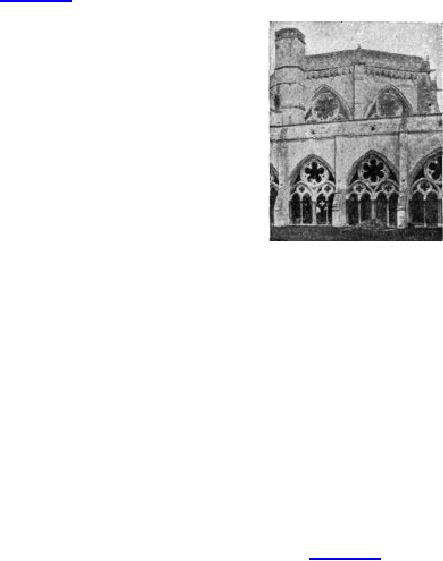
central
one higher than the others--a
surviving Norman practice. Plate-tracery
was,
as
in France, an intermediate step
leading to the development of bar-tracery
(see
Fig.
110).
FIG.
132.--CLOISTERS, SALISBURY CATHEDRAL
(SHOWING UPPER PART OF
CHAPTER-HOUSE).
The
English followed here the
same reasoning as the French. At
first the openings
constituted
the design, the intervening stonework
being of secondary
importance.
Later
the forms of the openings were
subordinated to the pattern of the
stone
framework
of bars, arches, circles, and
cusps. Bar-tracery of this
description
prevailed
in England through the greater part of the
Decorated Period (12801380),
and
somewhat resembled the contemporary
French geometric tracery, though
more
varied
and less rigidly constructive in
design. An early example of this
tracery occurs
in
the cloisters of Salisbury (Fig. 132);
others in the clearstories of the choirs
of
Lichfield,
Lincoln, and Ely, the nave of York, and the
chapter-houses mentioned
above,
where, indeed, it seems to
have received its earliest
development. After the
middle
of the fourteenth century lines of double
curvature were
introduced,
producing
what is called flowing
tracery,
somewhat resembling the
French
Wells,
in the side aisles and triforium of the
choir of Ely, and in the S. transept
rose-
window
of Lincoln.
THE
PERPENDICULAR STYLE. Flowing
tracery was, however, a
transitional phase
of
design, and was soon
superseded by Perpendicular
tracery,
in which the mullions
were
carried through to the top of the arch and
intersected by horizontal
transoms.
This
formed a very rigid and mechanically
correct system of stone
framing, but
lacked
the grace and charm of the two preceding
periods. The earliest examples
are
seen
in the work of Edington and of Wykeham in the
reconstructed cathedral of
Winchester
(13601394), where the tracery was
thus made to harmonize with the
accentuated
and multiplied vertical lines of the
interior design. It was at this
late
date
that the English seem first to
have fully appropriated the Gothic
ideas of
emphasized
vertical elements and wall surfaces
reduced to a minimum. The
development
of fan-vaulting had led to the adoption
of a new form of arch, the four-
centred
or Tudor
arch (Fig.
133), to fit under the depressed apex of the vault.
The
whole
design internally and externally
was thenceforward controlled by the form
of
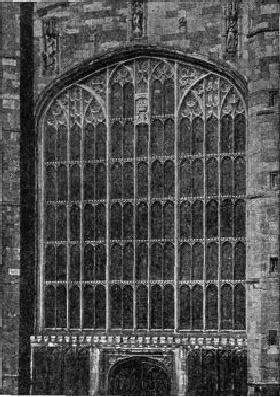
the
vaulting and of the openings. The windows
were made of enormous
size,
especially
at the east end of the choir, which
was square in nearly all
English
churches,
and in the west windows over the
entrance. These windows had
already
reached,
in the Decorated Period, an enormous
size, as at York; in the
Perpendicular
Period
the two ends of the church were as nearly
as possible converted into walls
of
glass.
The East Window of Gloucester reaches the
prodigious dimensions of 38 by 72
feet.
The most complete examples of the
Perpendicular tracery and of the style
in
general
are the three chapels
already mentioned; those, namely, of
King's
College at
Cambridge,
of St.
George at
Windsor, and of Henry
VII. in
Westminster Abbey.
FIG.
133.--PERPENDICULAR TRACERY, WEST
WINDOW OF ST. GEORGE'S,
WINDSOR.
CONSTRUCTIVE
DESIGN. The
most striking peculiarity of
English Gothic design
was
its studious avoidance of
temerity or venturesomeness in
construction. Both the
height
and width of the nave were kept within
very moderate bounds, and the
supports
were never reduced to
extreme slenderness. While much
impressiveness of
effect
was undoubtedly lost
thereby, there was some
gain in freedom of design,
and
there
was less obtrusion of
constructive elements in the exterior
composition. The
flying-buttress
became a feature of minor importance
where the clearstory was
kept
low,
as in most English churches. In many
cases the flying arches were
hidden under
the
aisle roofs. The English
cathedrals and larger churches
are long and low,
depending
for effect mainly upon the projecting
masses of their transepts, the
imposing
square central towers which
commonly crown the crossing, and
the
grouping
of the main structure with chapter-houses,
cloisters, and Lady-chapels.
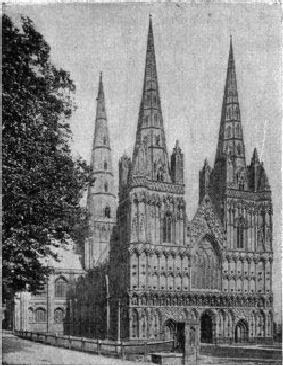
FIG.
134.--WEST FRONT, LICHFIELD
CATHEDRAL.
FRONTS.
The
sides and east ends were, in
most cases, more successful
than the
west
fronts. In these the English
displayed a singular indifference or
lack of creative
power.
They produced nothing to rival the
majestic façades of Notre
Dame, Amiens,
or
Reims, and their portals are
almost ridiculously small. The front of
York
Cathedral
is
the most notable in the list for
its size and elaborate
decoration. Those of Lincoln
and
Peterborough
are,
however, more interesting in the
picturesqueness and
singularity
of their composition. The first-named
forms a vast arcaded
screen,
masking
the bases of the two western towers, and
pierced by three huge
Norman
arches,
retained from the original façade. The
west front of Peterborough is
likewise
a
mask or screen, mainly composed of
three colossal recessed
arches, whose vast
scale
completely dwarfs the little porches
which give admittance to the
church.
Salisbury
has a curiously illogical and
ineffective façade. Those of
Lichfield
and
Wells
are,
on the other hand, imposing and beautiful
designs, the first with its
twin
spires
and rich arcading (Fig. 134), the second
with its unusual wealth of
figure-
sculpture,
and massive square
towers.
CENTRAL
TOWERS. These
are the most successful
features of English
exterior
design.
Most of them form lanterns internally
over the crossing, giving to that point
a
considerable
increase of dignity. Externally they are
usually massive and lofty
square
towers,
and having been for the most part
completed during the fourteenth
and
fifteenth
centuries they are marked by
great richness and elegance of
detail. Durham,
York,
Ely, Canterbury, Lincoln, and Gloucester
maybe mentioned as
notable
examples
of such square towers; that of
Canterbury is the finest. Two or three
have
lofty
spires over the lantern.
Among these, that of Salisbury is
chief, rising 424
feet
from
the ground, admirably designed in
every detail. It was not
completed till the
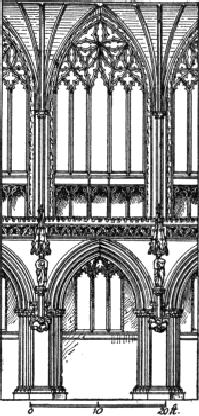
middle
of the fourteenth century, but most
fortunately carries out with great
felicity
the
spirit of the earlier style in which it
was begun. Lichfield and
Chichester have
somewhat
similar central spires, but
less happy in proportion and
detail than the
beautiful
Salisbury example.
FIG.
135.--ONE BAY OF CHOIR, LICHFIELD
CATHEDRAL.
INTERIOR
DESIGN. In the Norman
churches the pier-arches, triforium,
and
clearstory
were practically equal. In the
Gothic churches the pier-arches
generally
occupy
the lower half of the height, the upper
half being divided nearly
equally
between
the triforium and clearstory, as in Lincoln,
Lichfield (nave), Ely (choir).
In
some
cases, however (as at
Salisbury, Westminster, Winchester,
choir of Lichfield),
the
clearstory is magnified at the expense of
the triforium (Fig. 135). Three
peculiarities
of design sharply distinguish the
English treatment of these
features
from
the French. The first is the multiplicity
of fine mouldings in the pier-arches;
the
second
is the decorative elaboration of design
in the triforium; the third, the variety
in
the treatment of the clearstory. In
general the English interiors
are much more
ornate
than the French. Black Purbeck
marble is frequently used for the
shafts
clustered
around the central core of the
pier, giving a striking and
somewhat singular
effect
of contrasted color. The rich vaulting,
the highly decorated triforium, the
moulded
pier-arches, and at the end of the vista
the great east window, produce
an
impression
very different from the more simple and
lofty stateliness of the French
cathedrals.
The great length and lowness of the
English interiors combine with
this
decorative
richness to give the impression of
repose and grace, rather than of
majesty
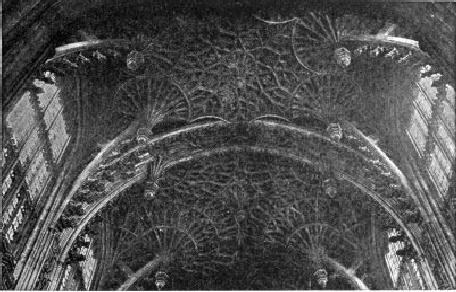
and
power. This tendency reached
its highest expression in the
Perpendicular
churches
and chapels, in which every surface
was covered with minute
panelling.
CARVING.
In the
Early English Period the
details were carved with a
combined
delicacy
and vigor deserving of the highest
praise. In the capitals and
corbels,
crockets
and finials, the foliage was
crisp and fine, curling into
convex masses and
seeming
to spring from the surface which it
decorated. Mouldings were
frequently
ornamented
with foliage of this character in the
hollows, and another ornament,
the
dog-tooth
or
pyramid,
often served the same
purpose, introducing repeated
points of
light
into the shadows of the mouldings. These
were fine and complex, deep
hollows
alternating
with round mouldings (bowtels)
sometimes made pear-shaped in
section
by
a fillet on one side.
Cusping--the
decoration of an arch or circle by
triangular
projections
on its inner edge--was introduced
during this period, and became
an
important
decorative resource, especially in
tracery design. In the Decorated
Period
the
foliage was less crisp;
sea-weed and oak-leaves, closely and
confusedly bunched,
were
used in the capitals, while crockets
were larger, double-curved, with
leaves
swelling
into convexities like oak-galls.
Geometrical and flowing tracery
were
developed,
and the mouldings of the tracery-bars, as of
other features, lost
somewhat
in
vigor and sharpness. The ball-flower
or button
replaced the dog's-tooth, and the
hollows
were less frequently adorned
with foliage.
In
the Perpendicular Period nearly all flat
surfaces were panelled in
designs
resembling
the tracery of the windows. The capitals
were less important than
those
of
the preceding periods, and the mouldings
weaker and less effective. The
Tudor
rose
appears as an ornament in square
panels and on flat surfaces; and
moulded
battlements,
which first appeared in Decorated work,
now become a frequent
crowning
motive in place of a cornice.
There is less originality and
variety in the
ornament,
but a great increase in its amount
(Fig. 136).
FIG.
136.--FAN-VAULTING, HENRY VII.'S
CHAPEL, WESTMINSTER
ABBEY.
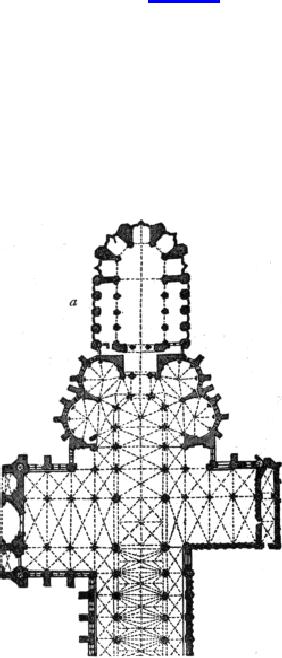
PLANS.
English
church plans underwent, during the
Gothic Period, but little
change
from
the general types established
previous to the thirteenth century. The
Gothic
cathedrals
and abbeys, like the Norman, were very
long and narrow, with choirs
often
nearly as long as the nave, and
almost invariably with square
eastward
terminations.
There is no example of double
side aisles and side
chapels, and apsidal
chapels
are very rare. Canterbury and
Westminster (Fig. 137) are the
chief
exceptions
to this, and both show clearly the French
influence. Another
striking
peculiarity
of the English plans is the frequent
occurrence of secondary
transepts,
adding
greatly to the external picturesqueness.
These occur in rudimentary form
in
Canterbury,
and at Durham the Chapel of the Nine Altars,
added 12421290 to the
eastern
end, forms in reality a
secondary transept. This
feature is most
perfectly
Worcester,
Wells, and a few other examples. The
English cathedral plans are
also
distinguished
by the retention or incorporation of many
conventual features, such
as
cloisters,
libraries, and halls, and by the grouping
of chapter-houses and Lady-
chapels
with the main edifice. Thus the English
cathedral plans and those of
the
great
abbey churches present a
marked contrast with those of
France and the
Continent
generally. While Amiens, the
greatest of French cathedrals, is 521
feet
long,
and internally 140 feet high, Ely
measures 565 feet in length, and
less than 75
feet
in height. Notre Dame is 148
feet wide; the English naves
are usually under 80
feet
in total width of the three
aisles.
FIG.
137.--EASTERN HALF OF WESTMINSTER
ABBEY. PLAN.
a,
Henry VII.'s
chapel.
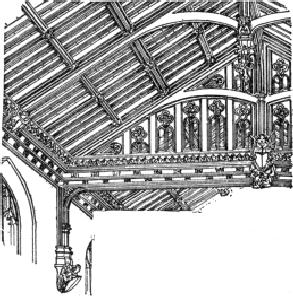
PARISH
CHURCHES. Many of
these were of exceptional
beauty of composition and
detail.
They display the greatest variety of
plan, churches with two
equal-gabled
naves
side by side being not
uncommon. A considerable proportion of
them date
from
the fourteenth and fifteenth centuries,
and are chiefly interesting for
their
square,
single, west towers and their
carved wooden ceilings (see
below). The tower
was
usually built over the central
western porch; broad and
square, with corner
buttresses
terminating in pinnacles, it was
usually finished without spires.
Crenelated
battlements
crowned the upper story. When spires
were added the transition
from
the
square tower to the octagonal
spire was effected by
broaches
or
portions of a
square
pyramid intersecting the base of the
spire, or by corner pinnacles and
flying-
buttresses.
FIG.
138.--ROOF OF NAVE, ST.
MARY'S, WESTONZOYLAND.
WOODEN
CEILINGS. The
English treated woodwork with
consummate skill. They
invented
and developed a variety of forms of
roof-truss in which the proper
distribution
of the strains was combined with a highly
decorative treatment of the
several
parts by carving, moulding, and
arcading. The ceiling surfaces
between the
trusses
were handled decoratively, and the
oaken open-timber ceilings of many of
the
English
churches and civic or academic
halls (Christ Church Hall,
Oxford;
Westminster
Hall, London) are such noble
and beautiful works as quite to justify
the
substitution
of wooden for vaulted ceilings
(Fig. 138). The hammer-beam
truss
was
in
its way as highly scientific, and
æsthetically as satisfactory, as any
feature of
French
Gothic stone construction. Without the
use of tie-rods to keep the
rafters from
spreading,
it brought the strain of the roof upon
internal brackets low down on the
wall,
and produced a beautiful effect by the
repetition of its graceful
curves in each
truss.
CHAPELS
AND HALLS. Many of
these rival the cathedrals in beauty and
dignity of
design.
The royal chapels at Windsor and
Westminster have already
been mentioned,
as
well as King's College Chapel at
Cambridge, and Christ Church Hall at
Oxford. To
these
college halls should be
added the chapel of Merton College at
Oxford, and the
beautiful
chapel of St. Stephen at
Westminster, most unfortunately
demolished when
the
present Parliament House was
erected. The Lady-chapels of Gloucester
and Ely,
though
connected with the cathedrals, are
really independent designs of
late date,
and
remarkable for the richness of their
decoration, their great windows,
and
elaborate
ribbed vaulting. Some of the
halls in mediæval castles and
manor-houses
are
also worthy of note, especially for their
timber ceilings.
MINOR
MONUMENTS. The
student of Gothic architecture
should also give
attention
to the choir-screens, tombs, and
chantries which embellish many of
the
abbeys
and cathedrals. The rood-screen at York is a
notable example of the first;
the
tomb
of De Gray in the same cathedral, and
tombs and chantries in
Canterbury,
Winchester,
Westminster Abbey, Ely, St.
Alban's Abbey, and other
churches are
deservedly
admired. In these the English
love for ornament, for minute carving,
and
for
the contrast of white and colored marble,
found unrestrained expression. To
these
should
be added the market-crosses of Salisbury
and Winchester, and Queen
Eleanor's
Cross at Waltham.
DOMESTIC
ARCHITECTURE. The
mediæval castles of Great
Britain belong to the
domain
of military engineering rather than of the
history of art, though
occasionally
presenting
to view details of considerable
architectural beauty. The growth of
peace
and
civic order is marked by the
erection of manor-houses, the residences
of wealthy
landowners.
Some of these houses are of
imposing size, and show the application
to
domestic
requirements, of the late Gothic
style which prevailed in the period
to
which
most of them belong. The windows are
square or Tudor-arched, with
stone
mullions
and transoms of the Perpendicular style,
and the walls terminate in
merlons
or
crenelated parapets, recalling the
earlier military structures. The palace
of the
bishop
or archbishop, adjoining the cathedral,
and the residences of the dean,
canons,
and clergy, together with the libraries,
schools, and gates of the
cathedral
enclosure,
illustrate other phases of
secular Gothic work. Few of
these structures are
of
striking architectural merit, but they
possess a picturesque charm which is
very
attractive.
Not
many stone houses of the smaller
class remain from the Gothic
period in
England.
But there is hardly an old town that does not
retain many of the half-
timbered
dwellings of the fifteenth or even
fourteenth century, some of them
in
excellent
preservation. They are for the most part
wider and lower than the
French
houses
of the same class, but are built on the
same principle, and, like them,
the
woodwork
is more or less richly
carved.
MONUMENTS:
(A. = abbey church; C. =
cathedral; r. = ruined; trans. =
transept; each
monument
is given under the date of
the earliest extant Gothic
work upon it, with
additions
of later periods in
parentheses.)
EARLY ENGLISH: Kirkstall A., 115282,
first pointed arches;
Canterbury C., choir,
1175
84
(nave, 13781411; central tower,
1500); Lincoln C., choir,
trans., 11921200
(vault,
1250; nave and E. end, 126080);
Lichfield C., 120050 (W.
front, 1275;
presbytery,
1325); Worcester C., choir,
120318, nave partly Norman
(W. end, 1375
95);
Chichester C., 120444 (spire
rebuilt 17th century); Fountains
A., 120546;
Salisbury
C., 122058 (cloister, chapter-h.,
126384; spire, 1331); Elgin
C., 122444;
Wells
C., 11751206 (W. front 1225,
choir later, chapter-h.,
1292); Rochester C.,
122539
(nave Norman); York C., S.
trans., 1225; N. trans., 1260 (nave,
chapter-h.,
12911345;
W. window, 1338; central tower, 13891407; E.
window, 1407);
Southwell
Minster, 123394 (nave Norman);
Ripon C., 123394 (central
tower, 1459);
Ely
C., choir, 122954
(nave Norman; octagon
and presbytery,
132362);
Peterborough
C., W. front, 1237 (nave
Norman; retro-choir, late 14th
century);
Netley
A., 1239 (r.); Durham C.,
"Nine Altars" and E. end
choir, 123590 (nave,
choir,
Norman;
W. window, 1341; central tower finished,
1480); Glasgow C., (with
remarkable
Early
English crypt), 124277; Gloucester
C., nave vaulted, 123942
(nave mainly
Norman;
choir, 133751; cloisters, 13751412; W.
end, 142037; central
tower,
145057);
Westminster A., 124569; St.
Mary's A., York, 127292
(r.).
DECORATED:
Merton College Chapel,
Oxford, 12741300; Hereford C., N.
trans.,
chapter-h.,
cloisters, vaulting, 127592 (nave,
choir, Norman); Exeter C.,
choir, trans.,
127991;
nave, 133150 (E. end
remodelled, 1390); Lichfield
C., Lady-chapel, 1310;
Ely
C., Lady-chapel, 132149; Melrose
A., 132799 (nave, 1500; r.);
St. Stephen's
Chapel,
Westminster, 134964 (demolished);
Edington church, 135261; Carlisle
C.,
E.
end and upper parts,
135295 (nave in part and S.
trans. Norman; tower
finished,
1419);
Winchester C., W. end
remodelled, 136066 (nave and
aisles, 13941410;
trans.,
partly Norman); York C.,
Lady-chapel, 136272; churches of
Patrington and Hull,
late
14th century.
PERPENDICULAR: Holy Cross Church,
Canterbury, 1380; St. Mary's,
Warwick, 138191;
Manchester
C., 1422; St. Mary's, Bury
St. Edmunds, 142433; Beauchamp
Chapel,
Warwick,
1439; King's College Chapel,
Cambridge, 1440; vaults, 150815; St.
Mary's
Redcliffe,
Bristol, 1442; Roslyn Chapel,
Edinburgh, 144690; Gloucester C.,
Lady-
chapel,
145798; St. Mary's,
Stratford-on-Avon, 146591; Norwich
C., upper part
and
E.
end of choir, 147299 (the
rest mainly Norman); St.
George's Chapel,
Windsor,
14811508;
choir vaulted, 150720; Bath
A., 150039; Chapel of Henry
VII.,
Westminster,
150320.
ACADEMIC AND SECULAR BUILDINGS: Winchester Castle Hall,
122235; Merton College
Chapel,
Oxford, 12741300; Library Merton
College, 135478; Norborough
Hall,
1356;
Windsor Castle, upper ward,
135973; Winchester College, 138793;
Wardour
Castle,
1392; Westminster Hall, rebuilt,
139799; St. Mary's Hall,
Coventry, 140114;
Warkworth
Castle, 1440; St. John's
College, All Soul's College,
Oxford, 1437; Eton
College,
14411522; Divinity Schools, Oxford,
144554; Magdalen College,
Oxford,
147580,
tower, 1500; Christ Church
Hall, Oxford, 1529.
Table of Contents:
- PRIMITIVE AND PREHISTORIC ARCHITECTURE:EARLY BEGINNINGS
- EGYPTIAN ARCHITECTURE:LAND AND PEOPLE, THE MIDDLE EMPIRE
- EGYPTIAN ARCHITECTURE—Continued:TEMPLES, CAPITALS
- CHALDÆAN AND ASSYRIAN ARCHITECTURE:ORNAMENT, MONUMENTS
- PERSIAN, LYCIAN AND JEWISH ARCHITECTURE:Jehovah
- GREEK ARCHITECTURE:GENERAL CONSIDERATIONS, THE DORIC
- GREEK ARCHITECTURE—Continued:ARCHAIC PERIOD, THE TRANSITION
- ROMAN ARCHITECTURE:LAND AND PEOPLE, GREEK INFLUENCE
- ROMAN ARCHITECTURE—Continued:IMPERIAL ARCHITECTURE
- EARLY CHRISTIAN ARCHITECTURE:INTRODUCTORY, RAVENNA
- BYZANTINE ARCHITECTURE:DOMES, DECORATION, CARVED DETAILS
- SASSANIAN AND MOHAMMEDAN ARCHITECTURE:ARABIC ARCHITECTURE
- EARLY MEDIÆVAL ARCHITECTURE:LOMBARD STYLE, FLORENCE
- EARLY MEDIÆVAL ARCHITECTURE.—Continued:EARLY CHURCHES, GREAT BRITAIN
- GOTHIC ARCHITECTURE:STRUCTURAL PRINCIPLES, RIBBED VAULTING
- GOTHIC ARCHITECTURE IN FRANCE:STRUCTURAL DEVELOPMENT
- GOTHIC ARCHITECTURE IN GREAT BRITAIN:GENERAL CHARACTER
- GOTHIC ARCHITECTURE IN GERMANY, THE NETHERLANDS, AND SPAIN
- GOTHIC ARCHITECTURE IN ITALY:CLIMATE AND TRADITION, EARLY BUILDINGS.
- EARLY RENAISSANCE ARCHITECTURE IN ITALY:THE CLASSIC REVIVAL, PERIODS
- RENAISSANCE ARCHITECTURE IN ITALY—Continued:BRAMANTE’S WORKS
- RENAISSANCE ARCHITECTURE IN FRANCE:THE TRANSITION, CHURCHES
- RENAISSANCE ARCHITECTURE IN GREAT BRITAIN AND THE NETHERLANDS
- RENAISSANCE ARCHITECTURE IN GERMANY, SPAIN, AND PORTUGAL
- THE CLASSIC REVIVALS IN EUROPE:THE EIGHTEENTH CENTURY
- RECENT ARCHITECTURE IN EUROPE:MODERN CONDITIONS, FRANCE
- ARCHITECTURE IN THE UNITED STATES:GENERAL REMARKS, DWELLINGS
- ORIENTAL ARCHITECTURE:INTRODUCTORY NOTE, CHINESE ARCHITECTURE
- APPENDIX.